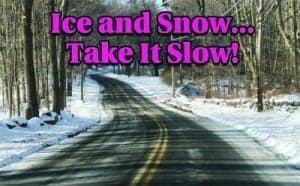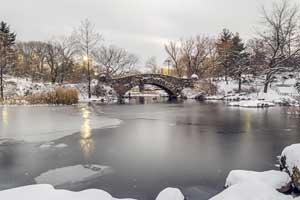With the New Year upon us, several people are still traveling around the country. Whether you are heading out for a New Year’s vacation to the slopes or coming home from visiting family over the holidays, be sure to plan your trip carefully while keeping in mind the ever-changing winter weather conditions. Here are a few winter weather travel tips.
A great way to plan your trip is to research some of the areas you will be traveling through on the interstates. Pinpoint locations that you would feel safe and comfortable stopping over night, especially if the winter weather becomes too much to bear. Look for exits that provide plenty of options for lodging, gas, and food.<more/>Even if you have already planned to stay over night while traveling to your destination, it is always a good idea to have a few back-up locations in mind. With the unpredictable winter weather, you may have to stop sooner than you originally planned. You can find the latest hotel deals and discounts here.
When traveling during the winter months, it is always a good idea to keep extra water and food, such as granola bars, peanut butter and jelly sandwiches, and even crackers, in the car. Make sure you have a tool bag or box equipped with a bright flashlight, jumper cables, an ice scrapper, etc. just in case of an emergency. You can also pack a small bag of kitty litter or play sand–it comes in handy if you get stuck and need traction. Whether you are traveling a long distance or just traveling a few hours from home, it is always good to be prepared and pack a bag of winter clothes, i.e., winter coats, ski pants, hats, gloves, extra socks, scarves, and even a blanket or two. You never know what can happen on the roadway so it is always good to prepare for the worst weather conditions.
AAA Car Club has fantastic tips and reminders for winter travel. Here is brief list of things that can be handy when traveling:
• Avoid driving when you are fatigued. You can reduce the chance of road mishaps if you drive after you are well rested.
• Give yourself plenty of time to get where you are going. That also means allowing your car at least 15 minutes to warm up before leaving.
• Check your tire pressure and keep at least half of a tank of gas in your vehicle. If you live in or are traveling to places that the temperatures are normally very low in the winter, not having at least half of a tank of gas can lead to frozen gas lines.
• Do not use cruise control, especially on wet surfaces. You need to be in control of your speed and need to have time to react to any situation.
• Make sure to wear your seat belt.
• If you get stranded on the roadway in a severe winter storm, do not leave your vehicle. It can provide temporary shelter until emergency crews can reach you.
• Do not over-exert yourself if you try to push or dig your vehicle out of the snow.
• Make sure your exhausts pipe is not clogged with snow, ice, or mud.
When driving in the snow, make sure you accelerate and decelerate slowly. Applying the gas slowly to accelerate is the best method for regaining traction and avoiding skids. Give yourself plenty of time to slow down, especially for an intersection. It takes a lot longer to slow down on icy roads. Give yourself plenty of time to maneuver–everything takes longer in the snow and ice.
AAA says that the normal following distance for dry pavement is three to four seconds. In snowy conditions, AAA suggests that the following distance be increased to eight to ten seconds. The greater the distance between you and the vehicle in front of you, the greater the time you have to react and stop.
A great tip when driving on snow-covered roadways: do not come to a complete stop if you can avoid it, i.e., stopping at a traffic light. There’s a huge difference in the amount of inertia it takes to start moving from a complete stop verses how much it takes while you’re still rolling. If you can slow down enough to keep rolling until a traffic light changes–do it. AAA also reminds you not to power up hills. Applying extra gas on snow-covered roads just starts your wheels spinning. Try building up inertia on a flat roadway before approaching a hill. Let that inertia pull you to the crest of the hill then begin to reduce your speed and proceed down the hill as slowly as possible. Also, do not stop while going up a hill. There is nothing worse than trying to get moving again when traveling up a hill on an icy or snow-covered road.
Give yourself plenty of time to get to your destination when you are traveling this season. And if you stop overnight while traveling be sure to get your Hotel Coupon to save some money on your hotel stay.




